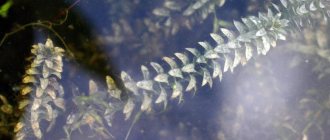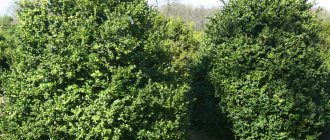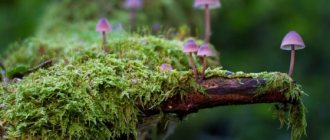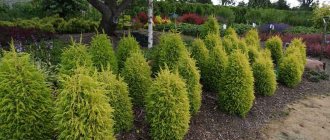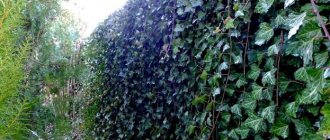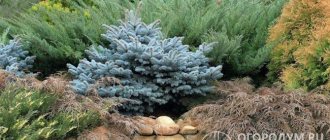The most popular types and varieties of fir trees
Mini conifers are very popular among gardeners. They are compact, look good in small flower beds, and have crowns of different decorative shapes.
Canadian spruce (Picea glauca)
The most popular compact decorative form of Canadian spruce in our gardens is Conica; it was found at the beginning of the last century in Canada and gave rise to a whole group of dwarf varieties. Conica spruce is distinguished by a thick, dense, pointed columnar crown with light green soft needles.
Mutants of Canadian spruce Conica are Laurin forms with extremely weak growth, not exceeding 1.5 m in height; Gnom with a conical crown, gray-green needles, growing annually by 3-5 cm and others, often sold under the name Conica.
Also interesting are the dwarf forms of Echiniformis - a very slowly growing plant, with yellow-green needles with a bluish-gray bloom, at the age of 30 years it can be 0.5 m high and about 1 m in diameter and Zuckerhut with bright green, very soft needles, dense , conical crown with a pointed top, height 1.5 m and diameter up to 0.8 m.
Prickly spruce (Picea pungens)
The popular form Glauca Globosa has a loose crown at a young age; over time it becomes flat-rounded, with very densely spaced branches.
Some semi-dwarf forms of prickly spruce are interesting. The Baby Blue Eyes form with a dense, pyramidal crown and long bluish-blue needles reaches a height of 4-5 m in adulthood.
The original form of Bialobok is named after the author, Polish gardener Jan Bialobok. A young tree has an asymmetrical crown; over time it becomes broadly conical; its height at the age of 10 years is about 2 m.
Norway spruce (Picea abies)
The widespread form of Acrocona with a wide-conical crown 2-3 m high and 2-4 m wide is distinguished by ascending and arched drooping shoots with dark green needles.
The miniature form of Lilliput at a young age has a dense, cushion-shaped crown, then becomes cone-shaped, at the age of 10 years it does not exceed 0.6 m.
The Little Gem form can be classified as microscopic, its growth is 2-3 cm per year, the shoots rise obliquely upward and form a cushion-shaped crown with a nest-like depression.
The round or nest-shaped crown of the Nidiformis form is formed by fan-shaped, obliquely growing branches, its height is up to 1.2 m, width up to 2.5 m, the needles are light green.
The miniature form of Pusch with a dense, rounded crown at the age of 10 years does not exceed 0.3 m in height and 0.6 m in diameter. The numerous reddish-purple young cones that form at the ends of the shoots look attractive.
One of the ancient forms of Pygmaea with a rounded crown no more than 1 m high and light green needles is common in gardens. Thanks to its narrow, columnar, dense crown and dwarf size (height no more than 2 m at the age of 30 years), the Will's Zwerg form is recommended as a Christmas tree for small areas.
With age, the lower branches droop in a trail and lie on the ground. The needles are thick, dark green with a bluish tint. Plant height no more than 1 m, diameter 4-5 m.
Serbian spruce (Picea omorica)
The most popular is the semi-dwarf form of Serbian spruce Nana, 4-5 m high and 3 m in diameter. The crown is dense, wide-columnar, and the needles are dark green.
Deciduous trees
Such trees have an unusually shaped crown and interesting leaf colors. They can be planted in groups, in single plantings or as a background for a flower garden.
The following views look beautiful on the site:
- red maple - with leaves of rich crimson color
- Purpurea maple - the outer side of the leaves is green and the inner side is burgundy;
- maple "Flamingo" - young leaves are pink, becoming variegated over time;
- maple Drummondii - with variegated leaves;
- felt linden - foliage with a silvery tint;
- white poplar - the underside of the leaf blades is whitish, due to which, when the wind blows, the foliage shimmers with a silvery tint;
- Rowan Magnifica - the leaves have silvery pubescence; by autumn, reddish-orange clusters ripen, which remain on the branches until frost.
These trees are best planted in areas with good visibility. For example, next to a gazebo, terrace, pond. Plant in sunny places or with light partial shade in full sun. In the shade they will lose their decorative effect.
Groups
This method involves creating compositions from several plants. Plants should be selected taking into account their ferocity. Tall shrubs should be planted in front of tall trees, and in front of which, in turn, it is better to plant low vegetation. To prevent the composition from being boring, it is better to choose plants with variegated leaves.
You can place such a group in the center of the garden. In this case, tall plants should be planted in the middle. If the group can only be seen on one side near a facade or fence, make sure that the height of the plants increases towards this structure.
When planning a group, the requirements of the plants should also be taken into account. In no case should they obscure each other. In addition, when planting plants, you should leave the necessary space between them.
Before purchasing trees for landscape design, you should know all their parameters: size, crown shape, growth rate and height.
Are you afraid of making a mistake? Then you need to make a dendroplane. Here you can accurately plan the planting of each type of plant. With this plan in hand, you can go to a garden center, which will recommend purchasing the appropriate plants.
Trees with the fastest growth
If your goal is to green up your area as quickly as possible, you should pay attention to the following trees:
Eucalyptus. In just 3 years after planting, it can reach a height of 10 m. By its tenth anniversary, it grows up to 25 m. However, the homeland of this tree is the tropics and subtropics. Therefore, it is grown only in the south of the country. In other regions, climatic conditions are unsuitable for it.
Birch. At its peak, birch can reach 200 cm. It quickly forms a beautiful shape and increases in trunk diameter. 4 years after planting it turns into a fairly large tree.
White willow. If you root a small shoot, it will grow into a spreading tree in 5 years, provided there is sufficient moisture.
Poplar. Its pyramidal forms grow fastest. It should be borne in mind that planting one tree is not enough. It takes several to create a well-shaded area.
White acacia or false acacia. This is a tree with spreading branches. Has nothing to do with acacia. Belongs to the genus Robinia. It blooms with snow-white inflorescences with a bewitching aroma.
Maple, elm, ash, bird cherry, aspen. These deciduous plants will also grow quite quickly.
Please note that in the first 10 years of life, the listed trees develop quickly. Then the pace slows down.
"High-speed" hardwoods
You can quickly green up a park area, alley, sanitary protection strips, and recreational areas by planting seedlings of deciduous trees with rapid growth. Owners of homestead territories and summer cottages use these types of vegetation to obtain dense greenery and abundant shade. Some varieties take root well and grow so quickly that after just a couple of years they look like powerful, mature trees.
Among them are the following breeds:
- Acacia. There are tree-like and tree-shrub forms. The species suitable for the middle zone is white acacia. It has a powerful root system that supplies the plant with water during drought, branched trunks with thorns, characterized by rapid growth, up to 1.5 m per year. Decorative and fragrant acacia flowers are collected in large tassels. Acacia is considered a weed, rapidly spreading by self-seeding, and a fast-growing tree. Every season, the area closest to the tree is filled with new thorny seedlings.
- Willow. It has many varieties with leaves of different shapes and shades. It takes root very easily and within a year grows into an almost adult tree 2.5 m tall. It has a spreading, curved crown and perfectly decorates artificial and natural reservoirs.
- Poplar. The poplar belongs to the fast-growing willow family. There are more than 100 species of poplars, both natural and hybrids. Trees quickly grow up to 30 m. Many species grow old and die after 20 years. Poplars have a peculiarity: “female” trees during the flowering period (May, June) spread fluff, which causes unpleasant symptoms in allergy sufferers.
- Maple. There are about 150 species of maple shrubs, tall and dwarf maple trees around the world. No more than 30 species are common in Russia, of which the most popular in the central part of the country is the holly or sycamore. Its growth rate with proper care and suitable soils is up to 2 m per year. Maple is famous for its carved leaves of various colors. The decorative form 'Crimson King' has impressive red-brown leaves, 'Crimson Sentry' has purple leaves, and 'Globosum', often found in European countries, has bright green leaves.
- Birch. The fastest growth is observed in the warty birch species - 2 m per year. The tree grows up to 25−30 m in height. The trunk of young seedlings is brown, after 8 years the bark turns white. The crown has a spreading shape, the branches bend strongly downwards.
Formation of coniferous plants
“Oh, my pine tree has grown into something big, I need to cut it down!” “This juniper has completely crushed the flowers, I’ll replant them.” Such phrases can often be heard, and it is a shame. Traditionally, our gardeners are sensitive to every sprout, including on conifers, and do not dare to remove or shorten it until it becomes large and powerful, a real problem. There is no need to bring the matter to the saw, especially since on conifers, unlike deciduous ones, traces of the removal of large parts of the crown will be very noticeable.
For best results, you need to constantly monitor where the growth is directed. You need to watch this especially carefully in late spring, when the shoots of the current year emerge. Unwanted ones can be stopped at the stage of bud opening, simply by pinching it off. In this way, you can reliably give the desired shape, and most importantly, maintain the desired size and prevent any coniferous plants from growing uncontrollably. After removing the shoot, three or four replacement shoots will begin to grow in its place, and the crown will become thicker and denser.
Of course, if we are talking about a spruce tree at least one and a half meters high, you may not have time to pluck out all the excess. You can trim spruce, pine, and juniper trees with pruning shears, but the sooner this is done, while the shoots of the current year have not yet become lignified, the better.
Hedges made from Norway spruce, which are pruned and plucked annually, turn out dense, completely impenetrable, and neat. At the same time, you need to remember that as soon as you stop removing the tops by cutting or plucking them, the trees will immediately go up sharply and the bottom of the fence will be exposed. If this happens to a hawthorn hedge, for example, you can cut it “to the stump” and it will grow again, you can restore its shape. This is impossible with a spruce fence, so systematic supervision is necessary.
You can also use other methods for forming the crown of coniferous plants, usually used on fruit plants: install guy wires, fix the trunk or branch in the desired direction - for weeping forms, it is advisable just not to injure the bark. Bare, elongated, damaged branches, everything that only spoils the view, can be removed at any time, both in summer and winter, if they are not very large, of course. The main thing is not to think that the form arises on its own once and for all. It can and should be corrected.
Basic cultivation requirements
Creating green sculptures will allow you to create an individual garden design without special costs
All coniferous plants are demanding of soil moisture and absorb water from the soil around the perimeter at a distance of up to three to five meters. If you do not plan garden plantings and flower beds, then you can safely opt for unpretentious pine trees or spectacular juniper.
Some recommendations from experienced gardeners:
- When to plant trees? In the middle zone - late May - early April, with minimal threat of severe frosts;
- When digging up a seedling in the forest, try to take as much turf as possible from the roots;
- For a month after planting, ensure regular watering and spraying;
- Pine roots can withstand open air for no more than two hours - then they die. Therefore, when replanting, try to limit the contact of the root system with air.
Advice. Renting a diesel generator for a summer cottage will help create the industrial cultivation of expensive tree species for sale, even in a small garden plot in a small greenhouse.
Which fast-growing conifers are the most unpretentious?
Criteria by which the unpretentiousness of fast-growing coniferous trees and shrubs is determined:
- frost resistance - no need to cover for the winter;
- rapid restoration of frost-damaged areas;
- drought resistance - the needles do not bake in the sun;
- undemanding to air humidity - the needles do not dry out or fall off;
- full vegetation on all types of soil;
- during the rainy season the crown does not lose its decorative effect.
Unpretentious fast-growing coniferous representatives of the flora include:
- junipers: Blue Arrow, horizontal Prince of Wales, Cossack;
- fir: balsam, monochrome, Douglas fir;
- thuja occidentalis;
- Serbian spruce;
- European larch;
- Weymouth pine.
Advice! In order for the plant to take root and give good growth, a variety is selected that is suitable for the climatic zone and soil composition.
